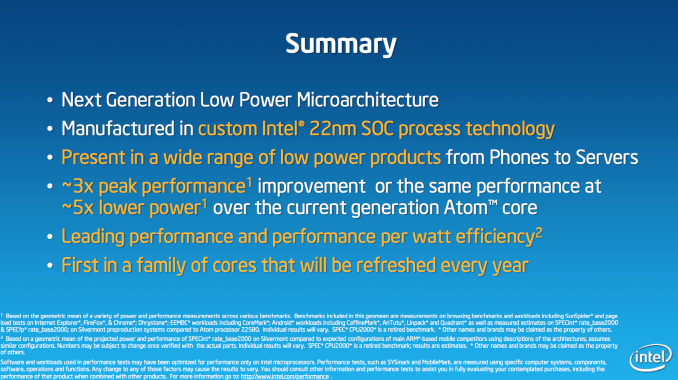Intel’s Silvermont Architecture Revealed: Getting Serious About Mobile
by Anand Lal Shimpi on May 6, 2013 1:00 PM EST- Posted in
- CPUs
- Intel
- Silvermont
- SoCs
Final Words
Silvermont really is Intel’s Conroe for the mobile market, but not in the sense that many have been expecting. Given that success in mobile is so closely tied to device wins, Silvermont alone isn’t enough. Unlike Conroe, a very competitive Silvermont won’t change the world overnight. What Silvermont does however is offer a great foundation for Intel going forward. Conroe lead to Penryn, Nehalem, Westmere, Sandy Bridge, Ivy Bridge and soon, Haswell. It was the platform that Intel could build on regularly by executing on tick-tock. Conroe paved the way for the insane advantage Intel has held onto for the past few years. Silvermont is like Conroe in that it provides that same foundation.
The mobile market is far more competitive than the PC industry was back when Conroe hit. There isn’t just one AMD but many competitors in the SoC space that are already very lean and fast moving. There’s also the fact that Intel doesn’t have tremendous marketshare in ultra mobile. Silvermont may feel a lot like Conroe, but the market it’s competing in is very different. That’s not to say that Intel can’t be successful here; it’s just not going to be easy.
Architecturally Silvermont is very conservative, and that’s not a bad thing. A side effect of not wanting to make Haswell irrelevant by a far lower cost part is the benefit of maintaining power efficiency. Intel joins the ranks of Apple and Qualcomm in intelligently scaling performance while respecting power consumption. Intel’s 22nm process should give Silvermont a lot of runway to use. If it can quickly follow up with 14nm, Silvermont’s power advantage could end up being akin to Conroe’s performance advantage in the mid-2000s.
Even so, Silvermont is long overdue. It’s the first mobile architecture where Intel really prioritized smartphones and tablets, and on paper, it looks very good. Now it’s up to Intel to turn a great architecture into great design wins. From what I’m hearing, we may actually see that happen.











174 Comments
View All Comments
Homeles - Monday, May 6, 2013 - link
Yay confirmation bias!R0H1T - Tuesday, May 7, 2013 - link
Nay, you fanboi(Intel's) much ?powerarmour - Monday, May 6, 2013 - link
Have to agree, starting to get tired of these almost Intel PR based previews. No mention to how poor Intel's graphics drivers have consistently been over many many years.Homeles - Monday, May 6, 2013 - link
"You can't make the ridiculous claims of 1.6x performance."Sure you can. It was already a close race between a 5 year old architecture and a brand new one. The floodgates have opened -- this is 5 years of pent up performance gains from the largest R&D spender in the industry, on top of being on a significantly superior process for mobile devices.
Wilco1 - Monday, May 6, 2013 - link
Absolute performance of Silvermont cannot be higher than A15 or Bobcat, it's just 2-way OoO, has a single-issue in-order memory pipeline (no speculative execution of memory operations or dual issue of load-store like A15/Bobcat) and fairly small buffers in general. All in all it is more like A9 than A15 or Bobcat/Jaguar.althaz - Monday, May 6, 2013 - link
Except that it certainly can (dependent on a lot of other factors)...That said, I suspect it will only be faster at the same power level, not at the same frequency.
beginner99 - Tuesday, May 7, 2013 - link
That's covered in the article but I must admit I don't fully understand it. Anyway Anand writes about macro-op fusion and clearly states that because of this the 2-wide is misleading when directly comparing to ARM. My interpretation being that ARM doesn't have this and if your 2-wide CPU is running macro-ops with 2 instructions in them it's actually like 4-wide (but I guess this naive viewpoint of mine is completely wrong.Wilco1 - Tuesday, May 7, 2013 - link
No, macro-ops don't make your CPU magically wider. For example Silvermont cannot actually execute 2 load+op instructions every cycle, and cannot even execute 1 read-modify-write every cycle...Also note that most ARM CPUs do have similar capabilities, for example Cortex-A9 can execute 2 shifts and 2 ALU instructions every cycle, and loads and stores can have base update for free. So Anand is quite wrong claiming this is an advantage to Atom.
As I mentioned, the big bottleneck of Silvermont is it's single load/store unit. Typical code contains many loads and stores, and Cortex-A15 can execute these twice as fast as Silvermont.
Jaybus - Wednesday, May 8, 2013 - link
It can, however, execute 1 load and 1 store simultaneously, and that is its saving grace. That fits very well with code being executed in OoO fashion and why I doubt very much A15 is twice as fast executing typical code.Wilco1 - Thursday, May 9, 2013 - link
No Silvermont can only execute 1 load or 1 store per cycle. A15 won't be twice as fast on typical code, but it will beat Silvermont on memory intensive code due to its single memory pipeline bottleneck.